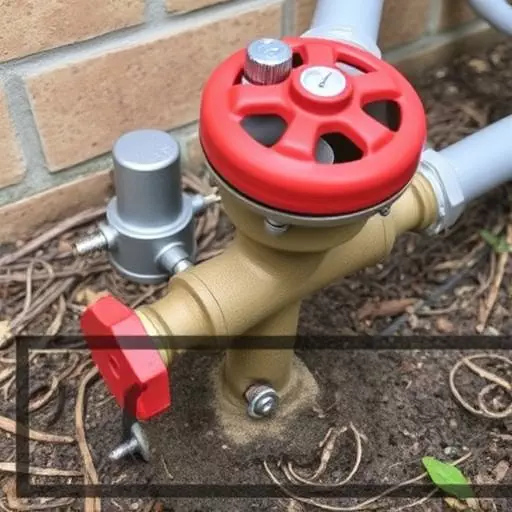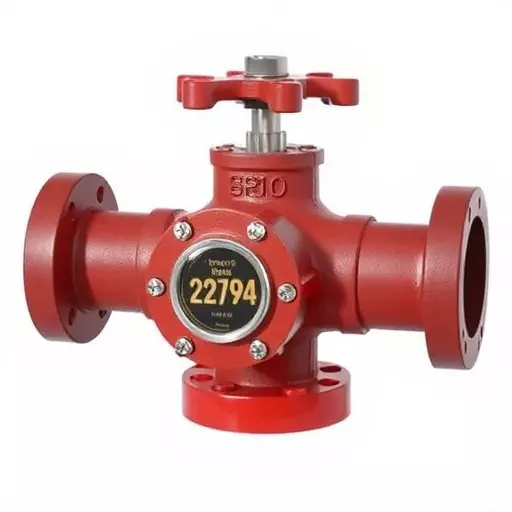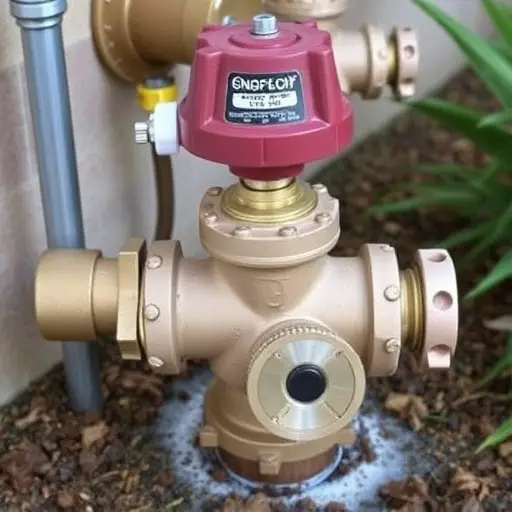Backflow preventers are safety mechanisms that protect potable water supplies from contamination. Common types include reduced pressure (RPBPs) and atmospheric backflow preventers. Regular maintenance and timely replacement, based on corrosion, leaks, or manufacturer recommendations, ensure effectiveness and compliance with OSHA guidelines. Jacksonville-based companies offer high-demand backflow preventer replacement services, with costs varying by device type and complexity. Regular inspections are crucial to determine optimal replacement time, considering age and environmental factors. Replacing a backflow preventer involves careful isolation, removal of the old device, installation of new, testing, and understanding associated costs. Budgeting for regular replacements is essential to maintain water quality, comply with OSHA standards, and avoid fines. Choosing licensed, insured professionals with expertise in backflow preventer replacement ensures safe, compliant water systems.
“In many industrial and commercial settings, backflow preventers play a vital role in maintaining safety standards, especially in Jacksonville. This article guides you through the essential aspects of backflow preventer replacement services, focusing on OSHA guidelines. We explore the critical function of these devices, their various types, and when it’s time for an upgrade. From understanding OSHA standards to choosing reliable contractors and post-replacement care, discover the key steps to ensure a safe and effective backflow preventer replacement process, including cost considerations.”
- Understanding Backflow Preventers: Their Role and Types
- OSHA Standards for Backflow Prevention
- When Is It Time to Replace a Backflow Preventer?
- Steps for Safe Backflow Preventer Replacement
- Cost Considerations: Budgeting for Replacement Services
- Choosing Reliable Backflow Preventer Replacement Contractors in Jacksonville
- Post-Replacement Maintenance and Testing Procedures
Understanding Backflow Preventers: Their Role and Types

Backflow preventers are critical safety devices designed to stop contaminated water from flowing back into potable water supplies. They protect your plumbing system and ensure that any hazardous substances or pollutants remain contained, preventing them from reentering the main water supply. These devices are particularly important in commercial and industrial settings where certain chemicals or processes could pose a risk to the wider community if mixed with drinking water.
There are various types of backflow preventers, each suited for specific applications. The most common include reduced pressure backflow preventers (RPBP), which use a pressure relief valve to stop backflow when a certain threshold is reached, and atmospheric backflow preventers, designed for low-pressure situations. Regular maintenance and eventual replacement are essential for these devices to maintain their effectiveness. In Jacksonville or any other location, understanding when to seek backflow preventer replacement services, such as when there’s noticeable corrosion, leaks, or the device has reached its manufacturer-recommended lifespan, is crucial for compliance with OSHA guidelines and ensuring the safety of your water supply. The cost of replacement can vary based on the type of backflow preventer and the complexity of installation or repair.
OSHA Standards for Backflow Prevention

The Occupational Safety and Health Administration (OSHA) sets stringent standards for backflow prevention to ensure the safety of workers and communities, especially in industrial and commercial settings. These standards are designed to prevent harmful substances from reversing flow and entering potable water systems. One crucial aspect is the regular replacement of backflow preventers, which act as a barrier to stop contaminants from backing up into water supplies.
Backflow preventer replacement services Jacksonville-based companies offer are in high demand due to the critical nature of these devices. The frequency of replacement depends on various factors, including the type of backflow preventer, local regulations, and the specific application. As a general guideline, when the backflow preventer shows signs of corrosion, leaks, or fails a pressure test, it’s time to consider replacement. Regular maintenance and timely repairs can extend the lifespan of these devices, ultimately reducing the need for costly backflow preventer replacement cost.
When Is It Time to Replace a Backflow Preventer?

Knowing when to replace your backflow preventer is crucial for maintaining water quality and safety. While these devices are designed to last, they can degrade over time, especially in harsh environments. One of the primary indicators that a replacement is necessary is age; most backflow preventers have a lifespan of around 10-15 years. If your unit is older than this, it’s wise to consider its condition and whether it’s still functioning optimally.
Various factors can accelerate the need for backflow preventer replacement services in Jacksonville. Corrosion, especially in areas with high moisture or salt content in the water, can weaken the device. Extreme temperatures can also impact performance. Additionally, if you’ve noticed any signs of damage, such as leaks, unusual noises, or if it has been subjected to flood conditions, these could indicate a need for prompt replacement to prevent potential contamination and ensure your plumbing system’s integrity. Regular inspections by professionals can help determine the optimal time for backflow preventer replacement, considering both age and environmental factors.
Steps for Safe Backflow Preventer Replacement

Replacing a backflow preventer requires careful navigation to ensure safety and comply with OSHA guidelines. The process begins by identifying when a replacement is necessary, which can be due to age, damage, or regulatory changes. It’s crucial to consult local regulations and, if in Jacksonville, consider professional backflow preventer replacement services to accurately assess the situation.
Next, isolate the water supply to prevent any accidental flow during the replacement. This step ensures the safety of your team and prevents potential contamination. After isolation, carefully remove the old backflow preventer, inspecting it for damage or wear. Once removed, install the new one, ensuring proper fitting and alignment. Finally, test the system post-replacement to verify its functionality and comply with backflow preventer replacement cost expectations.
Cost Considerations: Budgeting for Replacement Services

When considering backflow preventer replacement services in Jacksonville, budgeting is a key aspect. The cost can vary significantly depending on several factors, such as the type and age of the existing backflow device, any necessary repairs or upgrades, and whether you opt for a basic replacement or a more advanced model with added features. It’s important to remember that neglecting backflow preventer maintenance can lead to costly emergencies, so budgeting for regular replacement services is a proactive measure that ensures the safety of your water supply.
Determining when to replace a backflow preventer involves assessing its condition and performance. Regular inspections by certified professionals can help identify potential issues. While the initial cost may seem high, it pales in comparison to potential fines from OSHA or the risk of water contamination. Jacksonville residents and businesses should plan their budgets to include backflow preventer replacement services as a regular expense, ensuring compliance with safety standards and protecting their investment in clean, safe water.
Choosing Reliable Backflow Preventer Replacement Contractors in Jacksonville

Choosing reliable backflow preventer replacement contractors in Jacksonville is paramount for ensuring safe and compliant water systems. Look for licensed and insured professionals with extensive experience in backflow preventer installation and repair. Reputable contractors should adhere to OSHA guidelines and local regulations, guaranteeing a job well done. Online reviews and references from previous clients can help identify trustworthy providers.
When considering backflow preventer replacement cost, factor in not only the material expenses but also labor charges. Regular maintenance checks and timely replacements are crucial to prevent costly emergencies. Know the signs that indicate when to replace a backflow preventer, such as leaks, corrosion, or erratic water pressure. Proactive measures ensure the safety of your Jacksonville property and avoid potential legal issues related to non-compliance with OSHA standards.
Post-Replacement Maintenance and Testing Procedures

After successfully replacing a backflow preventer, proper maintenance and testing procedures are crucial to ensure its continued effectiveness. The first step involves regular visual inspections to check for any signs of damage or corrosion. This includes examining the device’s connections, valves, and overall structural integrity. Any issues detected should be addressed promptly by qualified professionals, who can perform detailed assessments and make necessary adjustments.
Additionally, it is recommended to schedule routine testing every few months to verify the backflow preventer’s functionality. These tests often include pressure checks and flow simulations to ensure the device operates as intended. By adhering to these maintenance and testing practices, Jacksonville residents and businesses can extend the lifespan of their backflow preventers and maintain compliance with OSHA guidelines, thereby mitigating potential health risks associated with water contamination.


